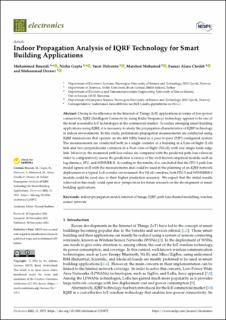| dc.contributor.author | Bouzidi, Mohammed | |
| dc.contributor.author | Gupta, Nishu | |
| dc.contributor.author | Dalveren, Yaser | |
| dc.contributor.author | Mohamed, Marshed Kassim | |
| dc.contributor.author | Alaya Cheikh, Faouzi | |
| dc.contributor.author | Derawi, Mohammad | |
| dc.date.accessioned | 2022-12-15T10:51:35Z | |
| dc.date.available | 2022-12-15T10:51:35Z | |
| dc.date.created | 2022-12-05T15:48:22Z | |
| dc.date.issued | 2022 | |
| dc.identifier.citation | Electronics. 2022, 11 (23), 1-14. | en_US |
| dc.identifier.issn | 2079-9292 | |
| dc.identifier.uri | https://hdl.handle.net/11250/3037970 | |
| dc.description.abstract | Owing to its efficiency in the Internet of Things (IoT) applications in terms of low-power connectivity, IQRF (Intelligent Connectivity using Radio Frequency) technology appears to be one of the most reasonable IoT technologies in the commercial market. To realize emerging smart building applications using IQRF, it is necessary to study the propagation characteristics of IQRF technology in indoor environments. In this study, preliminary propagation measurements are conducted using IQRF transceivers that operate on the 868 MHz band in a peer-to-peer (P2P) configured system. The measurements are conducted both in a single corridor of a building in a Line-of-Sight (LoS) link and two perpendicular corridors in a Non-Line-of-Sight (NLoS) with one single knife-edge link. Moreover, the measured path loss values are compared with the predicted path loss values in order to comparatively assess the prediction accuracy of the well-known empirical models, such as log-distance, ITU, and WINNER II. According to the results, it is concluded that the ITU-1 path loss model agrees well with the measurements and could be used in the planning of an IQRF network deployment in a typical LoS corridor environment. For NLoS corridors, both ITU-3 and WINNERII-2 models could be used due to their higher prediction accuracy. We expect that the initial results achieved in this study could open new perspectives for future research on the development of smart building applications. | en_US |
| dc.language.iso | eng | en_US |
| dc.publisher | MDPI | en_US |
| dc.rights | Navngivelse 4.0 Internasjonal | * |
| dc.rights.uri | http://creativecommons.org/licenses/by/4.0/deed.no | * |
| dc.title | Indoor Propagation Analysis of IQRF Technology for Smart Building Applications | en_US |
| dc.title.alternative | Indoor Propagation Analysis of IQRF Technology for Smart Building Applications | en_US |
| dc.type | Peer reviewed | en_US |
| dc.type | Journal article | en_US |
| dc.description.version | publishedVersion | en_US |
| dc.source.pagenumber | 1-14 | en_US |
| dc.source.volume | 11 | en_US |
| dc.source.journal | Electronics | en_US |
| dc.source.issue | 23 | en_US |
| dc.identifier.doi | 10.3390/electronics11233972 | |
| dc.identifier.cristin | 2088970 | |
| cristin.ispublished | true | |
| cristin.fulltext | original | |
| cristin.qualitycode | 1 | |

